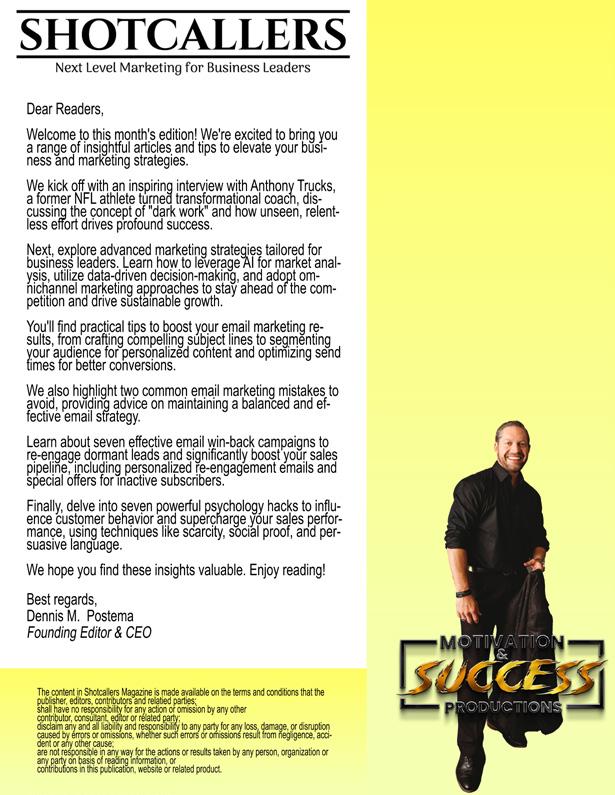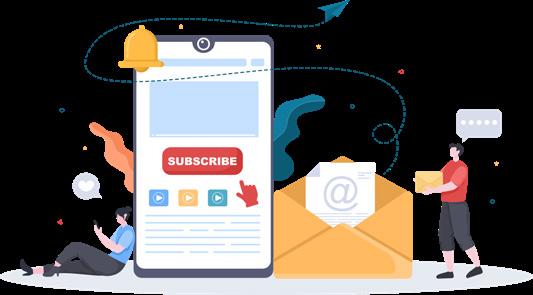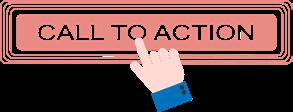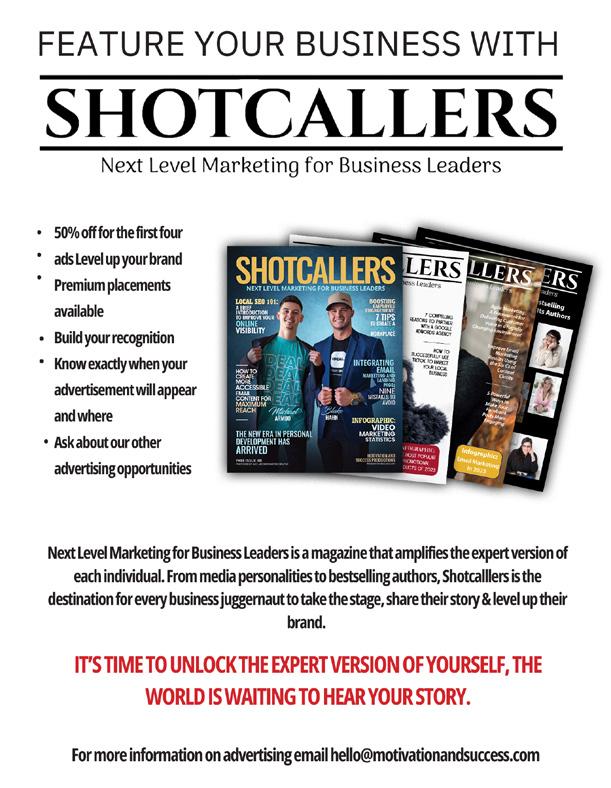7 Common Email Marketing Mistakes Every Small Business Needs to Avoid
For small businesses, email marketing remains a powerful channel for nurturing leads, driving sales, and building long-lasting customer relationships. However, many companies still unknowingly make costly mistakes that undermine their efforts. This guide explores seven common email marketing mistakes
made by small business owners and marketersand outlines strategies to help you avoid them.
Mistake #1: Not Building a Quality Email List
Let’s start with the foundation of any successful email program - your subscriber list. Without a quality,
engaged subscriber base, even the most brilliant email campaigns will fall flat. A critical mistake is purchasing third-party lists or emailing outdated contacts who never opted in. These “rented” lists yield poor engagement and can damage your sender reputation if flagged as spam by Internet Service Providers (ISPs).
Instead, focus your efforts on building an organic, permission-based email list. Offer incentives like discounts or exclusive content in exchange for signing up. Prominently display opt-in forms on your website and social channels. And be transparent about what kinds of emails they’ll receive - newsletters, promotional offers, or both. An email list of people actively interested in your content will drive significantly better engagement and results.
Mistake #2: Failing to Segment and Personalize
Your subscribers have varied interests, behaviors, demographics, and positions in the sales funnel - so treating them all the same is a surefire way to alienate your audience.
Segmenting your email list based on factors like location, purchase history, or content engagement allows you to create messaging that truly resonates with each group. Take it a step further with personalizationuse names in subject lines, reference purchase histories, or highlight
relevant products and offers.
The more you can make subscribers feel like the email was written just for them, the more likely they are to open it and take the next step. By sending targeted and personalized emails, you can significantly boost metrics like open rates, clicks, and conversions.
Mistake #3: Neglecting Mobile Optimization
In today’s mobile-driven world, optimizing emails for smaller touchscreens is non-negotiable. Failing to optimize for mobile can completely undermine the success of your campaigns and cause engagement rates to plummet.
The numbers don’t lie: most email opens happen on mobile devices - around 55 percent, according to one 2023 study. And that percentage is only expected to grow. If your emails aren’t responsive and easy to read on smartphones or tablets, your engagement is likely to suffer.
Use a mobile-responsive email builder and optimize all elements like images,
calls-to-action, and content for seamless, thumb-friendly viewing. Pay special attention to load times by compressing large multimedia files. And be sure to test your email templates on multiple devices and email clients to ensure a flawless experience for your audience, no matter how they’re accessing your emails.
Mistake #4: Poor Subject Lines and Preview Text
You could craft the most brilliant email content ever, but it won’t matter if the subject line fails to grab attention. Those few words are your first - and maybe only - chance to capture attention and stand out in crowded inboxes.
That’s why it’s crucial to create subject lines that are clear, compelling, and tailored to different audience segments. Use language that emphasizes key benefits, sparks curiosity, conveys urgency, or sparks an emotional response through persuasive word choice. And don’t underestimate the importance of preview text. Use this space to give readers a sneak peek of
what’s inside your email, build anticipation, or provide more context. Experiment with various combinations of subject lines and preview text to discover what resonates best with your audience.
Mistake #5: Lack of a Clear Call-to-Action
Even if people open your email, you need a clear and enticing primary call-to-action (CTA) to tell them what to do next. Without a strong, focused primary CTA, you’re missing out on a key conversion opportunity. One study found that emails with just a single CTA received 371 percent more clicks than those with multiple CTAs, highlighting the importance of making your main CTA the obvious focal point.
Make your primary CTA impossible to miss with eye-catching design and persuasive, actionable language that sells the benefits of clicking. Test different colors, sizes, placements, and styles to see what gets the most clicks from your audience. It’s also a good idea to include a secondary CTA for prospects who need more nurturing but ensure
that your primary CTA remains the clear focal point.
Mistake #6: Ignoring Email Marketing Metrics
To truly improve your results, you need to be data-driven. Key metrics like open, click-through, and conversion rates show you what resonates with your audience and what needs improvement. Don’t forget to track list growth, unsubscribe rates, and email sharing activity. These can reveal issues with deliverability or content that might be driving people away.
By regularly reviewing this data, you can identify strengths and weaknesses, then use those insights to test and optimize everything from subject lines to content and even send times.
Mistake #7: Inconsistent Branding and Voice
Keeping your brand voice and style consistent across all your emails is crucial. If your emails jump around in style, it can confuse people and weaken your credibility.
Use the same logo, color scheme, and branded
visuals throughout your emails and across all channels. More importantly, make sure your writing style matches your brand personality. If you’re a fun and friendly company, your emails shouldn’t sound like a stuffy textbook. The more consistent you are, the easier it will be for subscribers to recognize and trust your brand.
Continuous Improvement: The Key to Email Success
Avoiding these mistakes is a great first step, but the best email marketers are always learning. They constantly test new things, analyze results, and use what they learn to improve their campaigns.
So, keep a close eye on your email analytics. Learn from what works and what doesn’t and keep tweaking your emails to better resonate with your audience. With the right approach and a commitment to ongoing improvement, email marketing can be a powerful tool for generating leads and revenue for your small business.
Win the Light with Anthony Truck
Former National Football League player and American Ninja Warrior contestant Anthony Trucks shares advice on self-improvement, difficult conversations, and physical fitness. Presently, Anthony travels and helps companies optimize their identity for peak performance. He shares his concept of “dark work,” which refers to the unseen, difficult and misunderstood work that leads to personal growth and success.
Dennis Postema: What do you have going on in your life?
Anthony Trucks: My job involves traveling and talking. I get to use my voice to make an impact and an income. My brand, “Dark Work,” focuses on optimizing your identity for peak performance; I teach companies how to do dark work so they can win the light. I also teach entrepreneurs how I built my business, brick by brick, through speaking, coaching and consulting.
Dennis: What is dark work?
Anthony: Dark work is improving yourself once you know where your problems and bad habits stem from. It’s rooted in identity. We all have an identity—habits, instincts, actions and patterns that shape our lives.
I always tell people, “You cannot attain or sustain a dream above your current identity, because if you don’t have those actions, patterns and habits, you don’t get what that person has.”
How do we get those actions, patterns and habits? By experiencing
life. You don’t think about how you used to face challenges—you just face them as the person you are now.
Dark work is behind the scenes. It’s unseen, unsexy, difficult, ridiculed, mocked and misunderstood. When you do it, you develop skills, achieve amazing things and become a different person. You identify differently with new habits.
I think people are losing sight of self-improvement. We live in a soft world with low standards. People don’t develop thick skin anymore. They struggle to get what they want because they don’t have the gumption.
The good news is you can develop that thicker skin and those better habits. You must subject yourself to a process we call an “experience” that rewires you to have higher standards and to understand how to accomplish your goals.
Ask for feedback in ways that you don’t want it. Approach obstacles with a newfound sense of ownership. Taking action gets you to the point of having and holding
a higher standard that betters you. Over time, you’ll become that person who accomplishes their goals.
Dennis: How do you encourage people to be more open to discussing self-improvement?
Anthony: Often, when you ask someone what areas they could improve on, they focus on the hardest, most vulnerable topics. Our biggest problems are at the front of our mind.
If you think of yourself like a tree, you have roots and fruits. Roots give you a solid base to lean on when storms come, and the rain and sunshine are resources so you can produce fruit. If you nurture your roots, you’ll create better fruit.
Breaking your problems down makes them smaller and lets you focus on fixing them before they combine and become bigger problems.
I might look at ten problems and say, “Let’s unpack these ten things and see where they’re at,” and then I order them by priority and figure out what to work on first. This allows me to be intricate in an area I might not have noticed before.
If I ask someone what they need to improve, they might say their marriage, because it’s on the rocks and it’s all they think about. They might tell me, “I don’t want to talk about that. It’s a pretty personal thing.”
But if they chose to open up, I could find problems in other areas of their life that are impacting their marriage. “What if we look at your health? What if we look at your emotional control? What if we look at your friendships?”
Little did they know, their wife just wanted them to be healthy, to better manage their finances, to choose better friends, to not freak out when she gives them feedback. By working on other aspects of their life, their marriage would no longer be a problem.
These little things trickle in. Help someone open up. Give them time. Don’t put them on the spot—it’s too hard.
Dennis: How did you develop that process?
Anthony: Years ago, I happened across a picture of a wheel and realized you can gauge where
you’re at on each of the eight spokes. If the wheel can spin, you’re doing well. If one spoke is shorter than the others, the wheel is imbalanced, and it won’t spin properly. I remember thinking, “I don’t know if anybody ever has them all at the same length. I never do. So is my wheel ever going to spin?” I thought more about it. I loved the concept.
Going back to the tree analogy, I look at identity like this: We work hard,
and the fruit is the reward for our labor.
I wrote about this in my book, where I said, “I left football and the NFL. I thought I was the football. I was that fruit, and everything else around me didn’t matter. Just that piece of fruit. When it fell off the tree, it hung for a little bit, but eventually it rotted. I felt rotten, I felt useless, I felt like I couldn’t do anything.”
That’s when I realized that none of us have ever been
the fruit. We’ve always been the tree. We create the fruit in our life.
Life will always bring storms. When you only look at one piece of fruit and you don’t pay attention to the whole tree, the tree dies and takes the other fruit with it. Recently, I felt like I had problems poking me from different directions at the same time. It felt frustrating. Now, imagine my roots, as I call them, are faith, family, health, friends and emotional control.\
When everything was coming at me, if I didn’t have well-anchored faith, if I had a chaotic family, if I had no friends to confide in, if I was unhealthy, sick, tired, or if I had no emotional control, those problems could become a crazy turn of events.
But because I nurtured my roots, I was anchored when the storms of life came blowing. I was good. No problems.
I developed this process because I wanted to have something to look at, score, pay attention to and revisit later, so I created a zero-to-ten scale of how deep each root in your
life is. That way, others can look at it and say, “OK, great. If my roots are good, I can do a lot in my life. If I have a good base, I can create sweet fruit.”
The roots are career, education, finances, escape—going on trips and seeing the world— and purpose.
If I have those things in place, I can enjoy my career and not feel like I’m living in a whirlwind.
If I’m good with my finances, money won’t stress me out. I can learn from life, pay attention and have the bandwidth to learn about this cool world we live in. I can enjoy trips with great people. I can live a purposeful life because I’m stable, and I can share with the rest of the world.
It started as a thought and evolved into this process, and then I added the numbers in. How do I think about the depth of this? Zero to ten.
Dennis: How do you bounce back from obstacles in life?
Anthony: Perspective and gratitude. Perseverance is a matter of whether you’ll stop or what will make you stop. Nothing will make me stop, because even my problems are blessings.
I’ve built my life to a point where my problems are like, “My team isn’t functioning at the level I need them to,” but I have a team. Or “We invested $20,000 and we’re not earning it back,” but at least I have $20,000 to invest. That’s a blessing as a problem.
It’s not the end of the world. These are great problems to have.
I was in the foster system as a child. In some states, 75% of inmates are former foster children. Across the U.S., fewer than 5% graduate from a fouryear college; 50% of the homeless population has spent time in foster care. Statistically, I’m in a position I don’t belong in.
Then you can ask, “Why did I score myself this way? What is an action, pattern or habit I can build to improve this value in the next thirty days?”
A percentage of a percentage of kids who play football make it into the NFL. I spent two years in the NFL and I receive
some cool benefits from it.
My very first business opened in 2008 and I sold it in 2018. The odds of all these things happening are so small they don’t even fit if you combine them on a chart.
I operate every day fully aware of how bad life could be, so even during the bad times, I’m like, “Hell yeah, at least it ain’t as bad as it could be.” My energy comes from fulfillment and happiness, and I want to share it.
Dennis: Do you have a daily ritual to practice gratitude and faith?
Anthony: I don’t know if it’s a ritual per se. I operate in real time with that perspective. I have a great
God and I see things through His eyes. There’s humbleness there. Being able to play football at the highest level in the world helped me build this perspective. I have been around
people who had their noses in the air, thinking they were the greatest because, “I am the head of sales for this air conditioning filter company.”
You’re just a guy. But guess what? I’m just a guy too. I can give a speech in front of 10,000 people and then fly home in row B-2 on a commercial airplane. That reality set into me. I was like, “What’s the point of being arrogant when I’m just a guy? I’m one of God’s children. I’m a regular dude who does irregular stuff.” That’s how I look at it. Am I really a regular dude?
No, I know I’m not. I do different, cool things, but to my neighbors, I’m
the neighbor. To my kids, I’m their dad. To their teammates, I’m so-and-so’s dad.
That’s how I think we’re supposed to function. When I go into the world, I hold my ground. I know who I am and how I show up. Having the perspective of people in my life that tell me what I need to hear, not what I want to hear, keeps me grounded.
There’s a quote by Blair Enns that speaks to me: “You can’t read the label from inside the jar.” If I have a label on my jar, and the jar isn’t full, I might ask, “Why isn’t my jar full?” and there are people in my life who can read the label and say, “Here’s what you need to know about you.”
And then I’m able to pull back, listen and adjust my life. Most people don’t do that. I’m always in that place, and I can do that as a practice or ritual. I think most people don’t want to hear anything bad, and when they do, they shut down. They feel defensive.
For me, it’s more like, “All right, I’m not perfect,” and I’m able to listen without biting someone’s head off. I can hear it unemotionally and say, “Is that right? God,
you know what? You’re right. I do that.”
Years ago, my friend said to me, “Anthony, you talk so much that I have no idea if I’m ever going to get words in.”
His ex-wife agreed. She told me, “It’s always talking about yourself.”
It felt like a punch in the heart. I was just starting out with helping others build their own businesses. I said, “Yeah, you’re right. All right, I guess.”
Their feedback still pops into my head. I’ll notice that I’m talking too much, and I’ll stop. I’ll intentionally ask other people questions, and I’ll listen way longer than I would’ve in the past. I won’t butt in. I’m just there.
I think those improvements have made my conversations and relationships better. I have gotten more business from that feedback.
Imagine if I had responded with, “You’re a hater. You don’t like me.”
When I played professional football, my coach’s job was to say, “You’re one of
the best in the world, but you sucked at this play right here.” Imagine if I’d gotten pissed off every time the coach coached me. It would be weird.
You can receive great and not-so-great feedback, but we aren’t taught to discern between the two. When interacting with people now, I can tell when a person hasn’t played sports or been in the military because they can’t handle critical feedback.
When you’ve played sports for long enough, you’ll receive critical feedback and thank the person. When I go to these companies for consultation—and I’m talking Fortune 100 and Fortune 50 companies— the difference in the rooms is staggering. I’m in rooms with people who will say things that are so abrasive and direct, that if we were in a different environment, there’d be fistfights breaking out, but these people are mature and professional, and they understand why they’re being told something. They almost don’t care how it’s presented because they know they need to improve.
In other situations, we’re so
protective of our egos that we’re not worried about the outcome. People will tell you one thing, and they’re tiptoeing around. I can see when people are tiptoeing around a statement. It’s a waste of time. When you leave the room, maybe you understood and maybe you didn’t, but you repeat the same mistake.
But if someone said, “You need to stop talking to clients like this. They don’t appreciate it. They give me too much feedback,” or “This edit isn’t the way I need it. This is inadequate. It’s not good for the brand,” it doesn’t mean you’re bad at what you do, it just means you have room to improve. Let’s get better.
You want people who can hear that on your team. You’ll end up wondering how to get rid of the people who can’t hear that without upsetting them, and then everybody’s focus is derailed.
Dennis: How would you help someone develop the skill to speak directly?
Anthony: It depends on the recipient. You must set expectations so people know what’s
about to take place. You must practice too. If I know I’m going to have a difficult conversation, I will name that conversation something for the company, like, “Hey, we’re about to have a BLANK conversation.”
If they ask what that is, I’ll say, “It’s a tough one. I don’t want to have it and I know you don’t want to have it, but we need to have it.”
You don’t want to blindside people. The biggest reason people freak out when they have difficult conversations is because they feel blindsided. If you throw a rock at someone, they’re going to tense up, and they’re going to throw a rock back at you. It’s almost an instinct. If you tug at a dog’s leash, it’ll pull back. You must let them know what’s coming. “Hey, I’m about to throw a rock.”
“You are? OK, I’ll catch it.”
You need to guide the conversation. When you start
the conversation, say something like, “I’m going to tell you some things you aren’t going to want to hear, but I need you to hear them. I want us to reach this point. The goal of this conversation is to be in this space, and it’s an optimistic, positive place we’re reaching for.”
Remind them that the most beneficial places are the hardest to reach. That’s why the best views are from the top of waterfalls: You have to climb to get there.
Start by complimenting them. Butter them up, and then move into the next part of the conversation. “Here’s what I’m noticing we need to improve on.” Sometimes I tell them what I need to improve on before telling them what
they need to improve on. I might say, “Here is what you’re doing great at, here is what I think we need to work on, and this is something I need to do better.”
When you make yourself vulnerable, they’ll feel more comfortable accepting feedback from you.
Ask them for possible solutions and ask them what you can do to help them improve.
If we’re on the same side of a table, and there’s a problem, if I push it to you, you’re going to push it back, and then we go back and forth. If I get up and walk around the table, and we each grab the problem and move it, we can solve it together. Once you have collectively figured out how to solve the problem, you can express your gratitude and eagerness for the future, then end the conversation. Throughout the
conversation, the other person’s emotions will spike. In those moments, pause and take a breath. Don’t meet them where they’re at—it’ll only escalate the situation.
You could say, “I don’t want to argue. I do not want us to raise our voices. There is no need for that. We are professional adults. We can discuss this calmly.”
If they try to turn it around on you, you can say, “You’re right. I’m not perfect at that, and I do want to spend time addressing that, but right now let’s focus on what we can do to help you, because that’s the best use of our time, and if you want, we can discuss areas where I can improve after.” Keep bringing it back to center, focus, fix it and move forward.
People love praise. Celebrate their improvements in front of others. “Well done. Keep being who you are. Hey, Nick. Everybody, stop working for a second and listen. Nick did a great job on that count. We got this. We locked it in. Without you, it wouldn’t have happened.”
Since Nick was praised,
everyone else will work harder to be recognized too.
Little things add up and move everybody in the right direction. Most people avoid facing difficult conversations. It can’t be a one-way street. Make it two ways.
Dennis: How important is it to be coachable and trainable?
Anthony: Being coachable and trainable is critical because it’s the only way to improve. If you don’t have that, and you’re hoping you’ll “figure things out,” there’s no way to do that. You can’t see everything you do.
Sometimes we do things that we think are OK, and they’re not, even if we don’t do them intentionally. Unless somebody communicates that, you’re wandering around in the dark, and the worst part is you’re spinning your wheels, burning up energy.
You’re thinking, “I’ve done so much work, but I’m still not getting stuff done. What’s going on?”
That’s what we often face, and the reason is we’re
doing work but not our work.
If we harken back to identity, most people think, “I have to develop better habits,” and what do they do? They look at their heroes, at people they idolize and admire. They think, “Nick does that. I’ll do that too,” and start doing it. Then they burn out. Life is no better.
Why? Because Nick had certain holes in his bucket that he chose habits to fill. You have holes in your bucket that you’re using Nick’s habits to fill. Different locations. You’re doing all this work that Nick’s doing, but your bucket is still leaking. You must figure out your entire bucket and what work you need to do to fill those holes, and then you’ll do less work and have more success.
Dennis: I give people similar advice around diet and exercise. Everybody’s body is different, and we all have different nutrition and fitness needs. Speaking of which, what does a workout look like for you?
Anthony: It varies. I’m in an in-between state
right now where I want to look good naked and be functional, and it’s not always the same. Aesthetic training is different than athletic training. I’m trying to merge the two with bodybuilding and track workouts.
My wife does track. I want to do masters track and run, but I also don’t want to be so skinny that people will test me in public. I don’t need anybody looking at me sideways, wondering if they can take me in a fight.
My oldest son is a collegiate athlete and my twins do track and football too, so I built a home gym for our entire family. We live and train. It’s who we are, what we do.
At one point I owned six gyms, but I hated working out at them because people frequently interrupted me. When the pandemic hit, I had a membership at another gym, and I hated that because the equipment wasn’t well maintained, and the rules were nonexistent. People didn’t care.
There’s something to the emotional connection, the physical exertion
and psychological confidence that comes with exercising. If I’m not doing work, I’m working out. I might do a few sets of cores for the sake of it. Why not?
When you exert yourself past your limit, you feel proud. That’s why gym bros are so confident. They know how painful it was to push through that set of biceps. You have to work to get that. You can’t cheat your body.
I won’t get on stage to give a speech until I’ve worked out for the day. I need to get up there and ooze confidence. People should be able to look at me and know that I believe in this, and I live this.
When I look at people, I think, “I don’t think you know that no one believes you. I look at you, and I’m watching you,
and just looking at how you treat your own body. No one believes the motivation coming out of you, man. It sucks, but it’s reality.” It’s not my role to say anything, but I’m hoping they can sow the seed that helps them change some things.
Lead by example. In this world we live in, where I’m affecting someone’s life, there’s a subconscious part of it that, if they look at me and think, “He doesn’t eat what he’s cooking,” they’re not going to eat it either.
To reach Anthony Trucks, go to darkwork. com, anthonytrucks. com, or message him on Instagram: @ AnthonyTrucks.






























